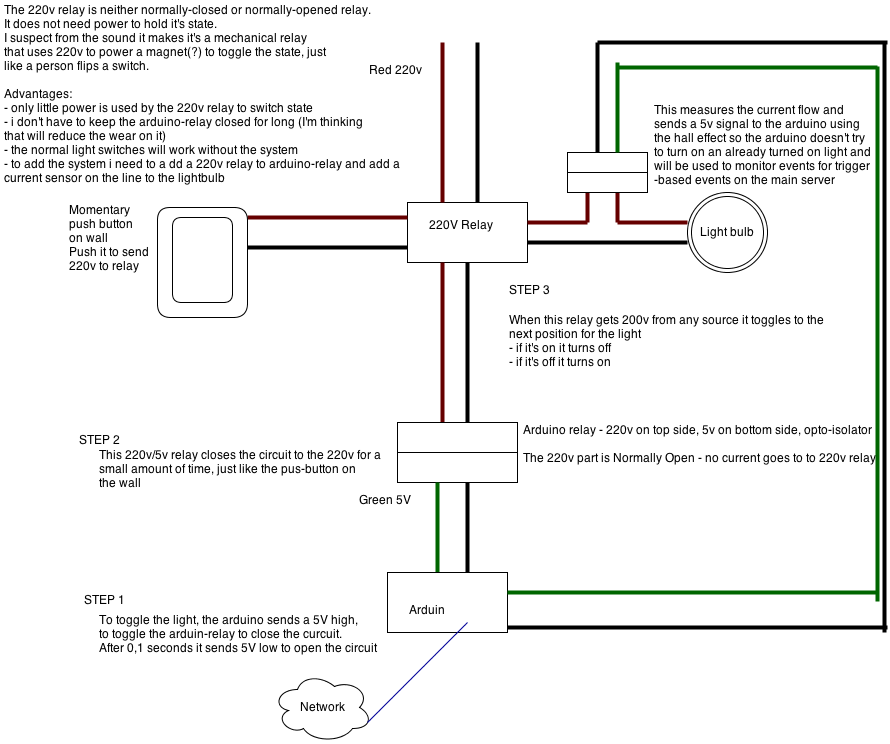Hi to all, first post in here. The situation is following: I have 220V relays in the house, connected to lights and 220V push buttons
I want to add an Arduino-controller 220V relay connected to the first one to send short "pulses" of 220V to toggle the existing ones on and off
By adding the Arduino-relay in parallel with existing switches i leave the original 'system' intact - if the Arduino stops working I can still use the lights normally, only losing the automation
To detect the state of a light, I plan on using ACS712-20A hall-effect modules
I'm good with writing software, but a novice regarding the electrical side of things.

Almost all lights are temporary push-buttons connected to a 220V relay
Two locations in the house where all the wires are connected adding a 220V relay in series with the normal light switches, connecting it to an Arduino
A 30 amp current sensor is used for detecting the state of the light switch
Each Arduino (or at least one in a pack of many Arduinos - where one won't be enough) Ethernet shield is used to send/receive data over a closed network (not accessible from LAN/internet)
The 220V relay that are set up right now were put into place to allow lights to be opened or closed from multiple places from a room. Think of the relay as a 3-sided control circuit
One side has the 220V mains coming in
One side has the push buttons that work on 220V
One side has the output to the light bulb
The 220V is an on/off relay. Each time any button is pushed, it toggles its state, as long as you press a button more than 0.1 seconds (so it said in the relay manual).
My electrician installed the 220V relay, it is not 'normally open' or 'normally closed'. If power goes down and then comes back the lights return to their previous states.
The Arduino-relay has a 5V side for the Arduino, a 220V side for the mains and each relay is rated to 20A at 220V. From my calculations a 100W light bulb is around 0.5A, and I am using 30W lights so I have plenty of margin for error.
To trigger the 220V mains relay all I have to do is use a normally-open Arduino-relay and trigger the closed state for more than 0.1 seconds. I just need to send a 220V "pulse" to the 220V relay.
This is the main reason that the lights will still work as long as power is kept. All the Arduino can fail and the normal lights will work as usual, I will only lose the remote-control possibility and advanced scheduling/scripting.
This is picture:

the top red line coming to the 220v relay is from the mains
the red lines on the left and down side of the 220v relay always have 220v on them.
Thanks all guys to taking for time to read.
I want to add an Arduino-controller 220V relay connected to the first one to send short "pulses" of 220V to toggle the existing ones on and off
By adding the Arduino-relay in parallel with existing switches i leave the original 'system' intact - if the Arduino stops working I can still use the lights normally, only losing the automation
To detect the state of a light, I plan on using ACS712-20A hall-effect modules
I'm good with writing software, but a novice regarding the electrical side of things.

Almost all lights are temporary push-buttons connected to a 220V relay
Two locations in the house where all the wires are connected adding a 220V relay in series with the normal light switches, connecting it to an Arduino
A 30 amp current sensor is used for detecting the state of the light switch
Each Arduino (or at least one in a pack of many Arduinos - where one won't be enough) Ethernet shield is used to send/receive data over a closed network (not accessible from LAN/internet)
The 220V relay that are set up right now were put into place to allow lights to be opened or closed from multiple places from a room. Think of the relay as a 3-sided control circuit
One side has the 220V mains coming in
One side has the push buttons that work on 220V
One side has the output to the light bulb
The 220V is an on/off relay. Each time any button is pushed, it toggles its state, as long as you press a button more than 0.1 seconds (so it said in the relay manual).
My electrician installed the 220V relay, it is not 'normally open' or 'normally closed'. If power goes down and then comes back the lights return to their previous states.
The Arduino-relay has a 5V side for the Arduino, a 220V side for the mains and each relay is rated to 20A at 220V. From my calculations a 100W light bulb is around 0.5A, and I am using 30W lights so I have plenty of margin for error.
To trigger the 220V mains relay all I have to do is use a normally-open Arduino-relay and trigger the closed state for more than 0.1 seconds. I just need to send a 220V "pulse" to the 220V relay.
This is the main reason that the lights will still work as long as power is kept. All the Arduino can fail and the normal lights will work as usual, I will only lose the remote-control possibility and advanced scheduling/scripting.
This is picture:

the top red line coming to the 220v relay is from the mains
the red lines on the left and down side of the 220v relay always have 220v on them.
Thanks all guys to taking for time to read.
